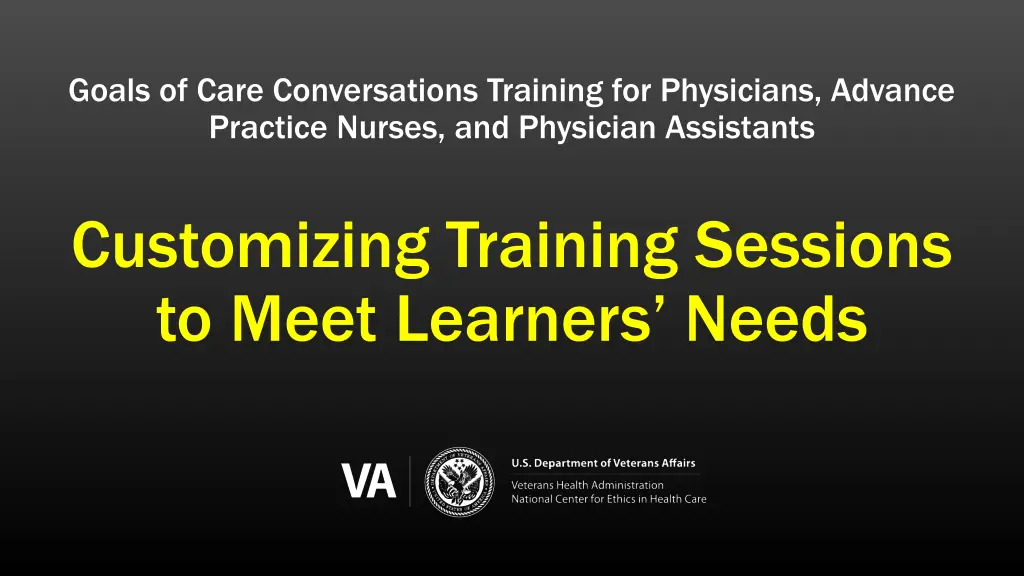
Effective Training Strategies for Goals of Care Conversations
Customizing training sessions to meet the individual needs of physicians, advance practice nurses, and physician assistants is key to successful conversations regarding goals of care. Learn how to adjust the curriculum based on learners' communication skill levels, experiences, and clinical responsibilities. Explore practical tips for enhancing practice sessions and adapting modules for different learner backgrounds. Gain insights into responding to emotions, naming and acknowledging feelings, and delivering serious news effectively.
Download Presentation

Please find below an Image/Link to download the presentation.
The content on the website is provided AS IS for your information and personal use only. It may not be sold, licensed, or shared on other websites without obtaining consent from the author. If you encounter any issues during the download, it is possible that the publisher has removed the file from their server.
You are allowed to download the files provided on this website for personal or commercial use, subject to the condition that they are used lawfully. All files are the property of their respective owners.
The content on the website is provided AS IS for your information and personal use only. It may not be sold, licensed, or shared on other websites without obtaining consent from the author.
E N D
Presentation Transcript
Goals of Care Conversations Training for Physicians, Advance Practice Nurses, and Physician Assistants Customizing Training Sessions to Meet Learners Needs
Not All Learners Are Alike Level of communication skill Experience with goals of care conversations Clinical responsibilities Adjust your curriculum based on learners needs 2
If Learners Could Use More Practice Schedule a Putting It All Together Practice session 3
If Learners Do Not Routinely Deliver Serious News Skip the Delivering Serious News module Make these adjustments to GoCC Part 1 : Remove Slides 3 - 4 (review of SPIKES) Add the following eight slides after Slide 12 (responding to emotion very important! very important!) Review Empathic Responses handout during GoCC, Part 1 4
SPIK SPIKE ES: S: E Emotion motion After hearing serious news, nearly everyone has an emotional reaction Clinicians must attend to that emotion BEFORE moving on to anything else Tools for responding to emotion: Naming Acknowledging I Wish
Naming Emotion Naming Emotion Naming emotions helps patients Know they ve been heard Identify what they are feeling Best done as a suggestion or humble question Some people would be angry I m wondering if you re feeling sad.
Naming Emotion Naming Emotion
What specifically did the clinician do that you liked?
Acknowledging Emotion Acknowledging Emotion A statement that conveys the clinician is trying to understand what the patient is going through It must be hard You can t truly understand patient experience, but you can show that you re trying Therefore, NEVER say: I understand exactly what you re feeling
Acknowledging Emotion Acknowledging Emotion
What specifically did the clinician do that you liked?
I wish Statement I wish Statement An I wish statement recognizes the patient s hope and aligns with the patient I wish you could get a transplant, too. NEVER follow with but I wish for a miracle, too, but it s not likely.
Topic: Decision-making Capacity Some learners could use a reminder about assessing the patient s capacity to make decisions about life-sustaining treatments before conducting goals of care conversations. In GoCC, Part 1, add the following two slides after Slide 8 13
Before You Begin Before You Begin Consider the patient s decision-making capacity Capacity = A clinical judgment about a patient s ability to make a particular health care decision Capacity = can do ALL Understand the relevant information Appreciate the situation and its consequences Reason about treatment options Communicate a choice ALL of the following:
Decision Decision- -making capacity making capacity If the patient lacks capacity, conduct the conversation with patient s authorized surrogate Capacity to make decisions about goals and life- sustaining treatments can be assessed during the goals of care conversation
Topic: Surrogate Decision Maker Some learners could benefit from guidance on identifying the patient s surrogate Learners can be taught to discuss the surrogate with the patient near the beginning of the conversation, or at the end, after establishing a treatment plan to support their goals. 16
Authorized Surrogate Authorized Surrogate The patient s authorized surrogate is the person(s) at the top of the VA surrogate hierarchy: 1. Health Care Agent (named in the patient s advance directive) 2. Legal or special guardian (appointed by a court of law) 3. Next of kin, 18+ years of age, in the following order of priority: spouse, child( ), parent(s), sibling(s),
Identifying the surrogate Identifying the surrogate It s helpful to know whom you would like to make health care decisions for you if you ever couldn t make decisions for yourself. Have you thought about who you would like this to be?
Authorized Surrogate Authorized Surrogate - - No Advance Directive No Advance Directive Without an advance directive, your [next-of-kin] would be recognized by law and VA policy to serve as your surrogate decision-maker when you can t make decisions for yourself. If you don t want your [next-of-kin] to make health care decisions for you, you can name someone else in an advance directive. Would you like [our social worker] to help you with that?
Topic: Prognostication Some learners could benefit from guidance on how to determine prognosis Deliver or email Prognostication slides 20
